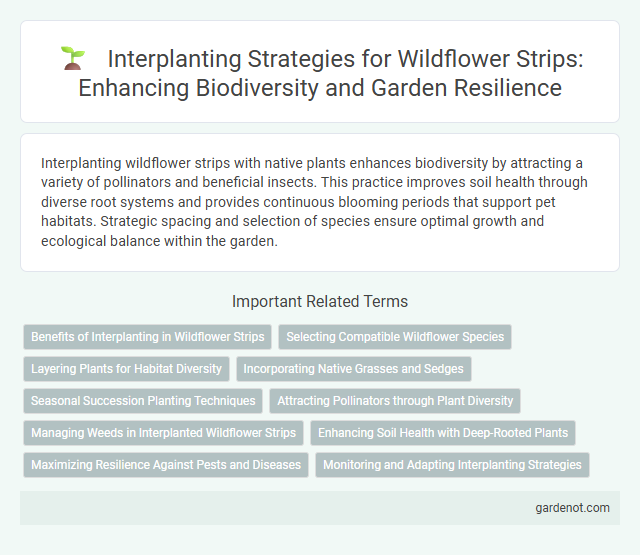Interplanting wildflower strips with native plants enhances biodiversity by attracting a variety of pollinators and beneficial insects. This practice improves soil health through diverse root systems and provides continuous blooming periods that support pet habitats. Strategic spacing and selection of species ensure optimal growth and ecological balance within the garden.
Benefits of Interplanting in Wildflower Strips
Interplanting in wildflower strips enhances biodiversity by providing continuous floral resources that attract a diverse range of pollinators and beneficial insects throughout the growing season. This practice improves pest management through natural predator support, reducing the need for chemical inputs and promoting ecosystem resilience. Furthermore, interplanting optimizes space utilization and soil health by fostering complementary plant interactions and nutrient cycling.
Selecting Compatible Wildflower Species
Selecting compatible wildflower species for interplanting involves choosing plants with complementary growth habits, bloom times, and soil requirements to ensure optimal coexistence and enhanced biodiversity within the wildflower strip. Species like coneflowers, black-eyed Susans, and native grasses provide diverse structural layers and staggered flowering periods, supporting pollinators throughout the growing season. Prioritizing native wildflowers adapted to local climate and soil conditions maximizes ecological benefits and promotes long-term strip resilience.
Layering Plants for Habitat Diversity
Interplanting wildflower strips with layered vegetation enhances habitat diversity by creating multiple niches for pollinators and beneficial insects. Combining ground covers, mid-height flowers, and tall grasses establishes a complex structure that supports diverse wildlife and improves ecosystem resilience. This stratified planting promotes prolonged blooming periods and optimizes resource use such as light, water, and nutrients.
Incorporating Native Grasses and Sedges
Incorporating native grasses and sedges into wildflower strips enhances biodiversity by providing essential habitat and food sources for pollinators and wildlife. Native species like Little Bluestem (Schizachyrium scoparium) and Pennsylvania Sedge (Carex pensylvanica) improve soil stability and water retention while complementing wildflowers with structural diversity. This interplanting strategy promotes ecosystem resilience and supports native plant communities adapted to local environmental conditions.
Seasonal Succession Planting Techniques
Seasonal succession planting techniques in wildflower strips maximize bloom periods by interplanting species with staggered flowering times, ensuring continuous habitat and forage for pollinators throughout the growing season. Early-blooming annuals, mid-season perennials, and late-flowering biennials are strategically combined to maintain biodiversity and sustain ecological functions. This method enhances pollinator visitation rates and supports ecosystem resilience by promoting a dynamic and temporally diverse floral landscape.
Attracting Pollinators through Plant Diversity
Interplanting diverse wildflower species in a strip enhances habitat complexity, providing varied nectar and pollen sources crucial for attracting a wide range of pollinators such as bees, butterflies, and hoverflies. Plant diversity supports the foraging preferences of different pollinator species, promoting ecosystem resilience and increasing pollination efficiency. This biodiversity-driven approach fosters sustainable agricultural practices by boosting crop yields through improved pollination services.
Managing Weeds in Interplanted Wildflower Strips
Interplanting wildflower strips enhances biodiversity while effectively managing weeds by creating competitive plant layers that suppress invasive species. Strategic selection of companion plants with varying growth habits and root depths reduces weed establishment and supports soil health. Regular monitoring and targeted hand weeding complement natural weed control, ensuring healthy wildflower growth and ecosystem balance.
Enhancing Soil Health with Deep-Rooted Plants
Interplanting wildflower strips with deep-rooted plants significantly enhances soil health by improving aeration and increasing nutrient cycling. These plants reach subsoil layers, breaking compacted soil and promoting beneficial microbial activity, which boosts organic matter decomposition. Incorporating species like purple coneflower and black-eyed Susan supports a diverse root structure that stabilizes soil and enhances moisture retention.
Maximizing Resilience Against Pests and Diseases
Interplanting diverse wildflower species within a wildflower strip enhances natural pest control by attracting beneficial insects such as ladybugs and parasitic wasps, which prey on harmful pests. This biodiversity disrupts pest life cycles and reduces the spread of diseases by limiting host-specific pathogens. Maximizing plant diversity promotes a resilient ecosystem, minimizing the need for chemical interventions while supporting pollinator health.
Monitoring and Adapting Interplanting Strategies
Monitoring wildflower strip interplanting involves regularly assessing plant growth, bloom timing, and species compatibility to ensure optimal biodiversity and pollinator attraction. Adapting interplanting strategies based on observed data helps address issues such as dominant species overgrowth or poor flowering performance. Continuous evaluation supports the enhancement of habitat quality and long-term ecological balance in wildflower strips.
Interplanting Infographic

 gardenot.com
gardenot.com